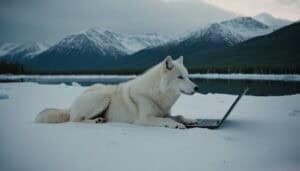Introduction
Arctic wolf conservation programs are vital for the preservation of this majestic species, which faces numerous threats in its harsh natural habitat
This article explores the main goals of these programs, highlights leading organizations involved in conservation efforts, and delves into the methods used to monitor wolf populations
Additionally, it addresses the challenges these programs encounter and showcases notable success stories, emphasizing the role of community and governmental support. Understanding these aspects provides a comprehensive view of the current state and future direction of Arctic wolf conservation
Main Goals of Arctic Wolf Conservation Programs
Conservation programs aimed at protecting the Arctic wolf are essential to ensure the species’ survival and the health of its ecosystem. These programs focus on several key goals to address the various challenges faced by the Arctic wolf in its natural habitat
Preservation of Habitat
One of the primary goals of Arctic wolf conservation programs is the preservation of their natural habitat. The Arctic tundra, characterized by its extreme cold and vast expanses, provides a unique environment that supports the biodiversity needed for the wolves’ survival
Efforts to preserve this habitat involve several strategies:
Protected Areas: Establishing protected areas where human activity is limited is crucial. These areas provide a safe haven for the wolves to hunt, breed, and thrive without the threat of human encroachment. National parks and wildlife reserves are examples of such protected areas
Sustainable Practices: Encouraging sustainable land use practices in regions surrounding the Arctic wolf’s habitat helps reduce the negative impact on the ecosystem. This includes promoting eco-friendly tourism, sustainable agriculture, and responsible natural resource extraction
Environmental Regulations: Implementing and enforcing environmental regulations that limit industrial activities, such as mining and oil drilling, in critical habitats ensures minimal disruption to the Arctic wolf’s environment
Genetic Diversity Maintenance
Maintaining genetic diversity within Arctic wolf populations is vital for their long-term survival. Genetic diversity helps populations adapt to changing environmental conditions and resist diseases
Conservation programs employ several methods to maintain and enhance genetic diversity:
Captive Breeding Programs: Captive breeding programs aim to increase the genetic pool by breeding wolves in controlled environments and later releasing them into the wild. These programs ensure that a diverse gene pool is maintained and that healthy individuals can contribute to wild populations
Genetic Research: Conducting genetic research helps identify genetic bottlenecks and inbreeding issues within wild populations. This information guides conservationists in implementing strategies to enhance genetic diversity, such as translocating individuals from different populations to prevent inbreeding
Wildlife Corridors: Establishing wildlife corridors that connect isolated populations allows for natural gene flow between groups. These corridors enable wolves to migrate and mate with individuals from different populations, enhancing genetic diversity
Population Monitoring
Accurate population monitoring is essential for effective conservation management. Understanding population dynamics, trends, and health allows conservationists to make informed decisions
Key methods for monitoring Arctic wolf populations include:
Tracking and Tagging Methods: Using GPS collars and radio tags, researchers can track the movements and behaviors of individual wolves. This data provides insights into their range, hunting patterns, and interactions with other species
Data Collection and Analysis: Regular surveys and data collection on wolf populations help estimate population sizes and monitor changes over time. This information is crucial for assessing the success of conservation efforts and identifying emerging threats
Technological Innovations: Advancements in technology, such as remote sensing and camera traps, have revolutionized wildlife monitoring. These tools allow researchers to collect data without disturbing the wolves, providing a more accurate and comprehensive picture of their populations
By focusing on these goals, Arctic wolf conservation programs aim to ensure the species’ survival and the health of their ecosystem. Through habitat preservation, genetic diversity maintenance, and population monitoring, these programs address the critical needs of the Arctic wolf and work towards a sustainable future for this iconic species
Leading Organizations in Arctic Wolf Conservation
Various organizations around the globe are dedicated to the conservation of the Arctic wolf. These organizations play a crucial role in research, policy-making, and on-the-ground efforts to protect this endangered species
Some of the leading entities in Arctic wolf conservation include the World Wildlife Fund (WWF), the Wildlife Conservation Society (WCS), and various local conservation groups
World Wildlife Fund (WWF)
The World Wildlife Fund is one of the foremost organizations dedicated to the conservation of the Arctic wolf. With its extensive network and resources, the WWF has been instrumental in numerous conservation initiatives:
Research and Monitoring: WWF conducts extensive research to understand the behavior, population dynamics, and threats faced by Arctic wolves. Their efforts in monitoring wolf populations provide essential data that guide conservation strategies
Habitat Protection: WWF actively works to protect critical habitats for Arctic wolves. This includes lobbying for the creation of protected areas, promoting sustainable land-use practices, and advocating for policies that reduce habitat destruction
Community Engagement: WWF engages with local communities to promote awareness and involvement in conservation efforts. By working closely with indigenous groups and local residents, WWF ensures that conservation strategies are culturally sensitive and sustainable
Wildlife Conservation Society (WCS)
The Wildlife Conservation Society is another key player in Arctic wolf conservation. Known for its scientific expertise and conservation initiatives, WCS contributes significantly to the understanding and preservation of this species:
Field Research: WCS conducts field research to gather data on Arctic wolf populations and their ecosystems. This research helps identify critical habitats, migration patterns, and the impacts of climate change on wolf populations
Policy Advocacy: WCS advocates for policies that protect Arctic wolves and their habitats. This includes working with governments and international bodies to implement regulations that mitigate threats such as industrial development and climate change
Conservation Programs: WCS implements conservation programs that focus on habitat restoration, species protection, and community-based conservation. These programs aim to create a balanced approach that considers ecological, economic, and social factors
Local Conservation Groups
Local conservation groups play a vital role in Arctic wolf conservation, often acting as the primary on-the-ground force in remote and challenging environments. These groups have an intimate understanding of the local ecosystems and the specific challenges faced by Arctic wolves:
Community-Based Conservation: Local groups often lead community-based conservation initiatives that involve local residents in protecting Arctic wolves. These initiatives may include educational programs, sustainable land-use practices, and wildlife monitoring projects
Rapid Response: Being based in the regions where Arctic wolves live, local conservation groups can respond quickly to emerging threats. This includes addressing issues such as poaching, habitat destruction, and conflicts between wolves and human activities
Partnerships: Local conservation groups frequently collaborate with larger organizations, governments, and research institutions. These partnerships enhance their capacity to implement effective conservation strategies and ensure that efforts are well-coordinated
The collaborative efforts of these organizations, each bringing their unique strengths and expertise, are essential for the successful conservation of Arctic wolves. Their combined initiatives help safeguard the future of this iconic species and the fragile ecosystems they inhabit
Monitoring Arctic Wolf Populations
Effective conservation of the Arctic wolf requires accurate and ongoing monitoring of their populations. Monitoring provides critical data that inform conservation strategies and help track the success of these initiatives. Several advanced techniques and methodologies are employed to ensure comprehensive and precise monitoring
Tracking and Tagging Methods
Tracking and tagging are fundamental techniques used to monitor Arctic wolves. These methods allow researchers to gather detailed information about the wolves’ movements, behavior, and interactions:
GPS Collars: GPS collars are commonly used to track the movement patterns of Arctic wolves. These collars transmit location data at regular intervals, providing insights into the wolves’ range, hunting areas, and migration routes. The data collected helps identify critical habitats and areas that need protection
Radio Tags: Radio tagging involves attaching small radio transmitters to the wolves, which emit signals that can be picked up by receivers. This method is particularly useful for tracking wolves in remote areas where GPS signals may be weak or unavailable. Researchers can follow the signals to locate and observe the wolves
Ear Tags and Microchips: Ear tags and microchips are less invasive methods for identifying individual wolves. While they do not provide real-time tracking data, they are valuable for long-term population studies and health assessments when wolves are captured or observed
Data Collection and Analysis
Collecting and analyzing data on Arctic wolf populations is crucial for understanding their dynamics and developing effective conservation strategies. Various methods are employed to gather and interpret this data:
Population Surveys: Regular population surveys involve counting wolves in specific areas to estimate overall population size and density. These surveys can be conducted through direct observation, camera traps, and aerial surveys. Accurate population estimates are essential for assessing the health and viability of wolf populations
Genetic Sampling: Genetic sampling involves collecting biological samples, such as fur or feces, to analyze the genetic diversity and relatedness of wolf populations. This information helps identify inbreeding issues and the need for genetic management. Genetic studies also provide insights into the wolves’ migration patterns and historical population changes
Ecological Data: Collecting ecological data, such as prey availability, habitat conditions, and climate variables, helps researchers understand the factors influencing wolf populations. This information is used to predict how changes in the environment may impact the wolves and to develop adaptive conservation strategies
Technological Innovations
Advancements in technology have revolutionized the monitoring of Arctic wolf populations, providing more accurate and comprehensive data with minimal disturbance to the animals:
Remote Sensing: Remote sensing technologies, such as satellite imagery and drones, are used to monitor large and inaccessible areas. These tools can track changes in the landscape, such as habitat loss or climate change impacts, that may affect wolf populations. Remote sensing data complements ground-based surveys, offering a broader perspective on the wolves’ environment
Camera Traps: Camera traps are motion-activated cameras placed in strategic locations to capture images and videos of wolves and other wildlife. These cameras provide valuable data on wolf behavior, social structure, and interactions with other species. Camera traps are particularly useful for studying nocturnal and elusive animals like the Arctic wolf
Acoustic Monitoring: Acoustic monitoring involves recording and analyzing the vocalizations of wolves. This method helps identify individual wolves, estimate population size, and study communication patterns. Acoustic data can also reveal the presence of wolves in areas where visual monitoring is challenging
By utilizing these advanced monitoring techniques, conservationists can gather comprehensive data on Arctic wolf populations. This information is essential for making informed decisions, adapting conservation strategies, and ensuring the long-term survival of this iconic species
Challenges in Arctic Wolf Conservation
Conserving the Arctic wolf is fraught with numerous challenges, stemming from environmental, social, and economic factors. Understanding these obstacles is critical for developing effective strategies to protect and sustain Arctic wolf populations
Climate Change Impact
Climate change poses a significant threat to the Arctic wolf, altering their habitat and affecting their prey availability:
Habitat Loss: Warming temperatures lead to the melting of Arctic ice and permafrost, transforming the tundra ecosystem. These changes reduce the habitat available for the Arctic wolf and other species that depend on cold environments
Prey Availability: Climate change affects the populations of prey species such as Arctic hares and lemmings, which the wolves rely on for food. Changes in prey abundance can lead to food scarcity, impacting wolf health and reproduction
Changing Migration Patterns: Altered climate conditions can disrupt the migration patterns of both wolves and their prey. This can lead to increased competition for food and territory, as well as difficulties in finding suitable hunting grounds
Human-Wildlife Conflict
Human activities in Arctic regions can lead to conflicts between people and wolves, posing significant challenges for conservation efforts:
Industrial Development: Activities such as mining, oil drilling, and infrastructure development can encroach on the wolves’ habitat, leading to habitat fragmentation and increased human-wolf encounters. These developments also bring noise and pollution, which can disrupt wolf behavior and health
Livestock Predation: In areas where Arctic wolves overlap with human settlements, wolves may prey on livestock, leading to conflicts with local farmers. This often results in retaliatory killing of wolves, further threatening their populations
Hunting and Poaching: Illegal hunting and poaching of Arctic wolves for their fur or as trophies remain significant threats. Despite legal protections, enforcement can be challenging in remote areas, allowing poaching to persist
Funding and Resource Limitations
Securing adequate funding and resources is essential for the successful implementation of conservation programs, yet it remains a persistent challenge:
Limited Financial Support: Conservation programs often rely on limited funding from governments, non-profits, and private donors. Insufficient financial support can hinder research, habitat protection, and community engagement efforts
Resource Allocation: Effective conservation requires substantial resources, including personnel, equipment, and technology. Limited resources can constrain the scope and effectiveness of conservation initiatives, making it difficult to address all the threats faced by Arctic wolves
Logistical Challenges: The remote and harsh environment of the Arctic makes conservation work logistically challenging. Accessing and monitoring wolf populations require significant effort and resources, complicating conservation activities
By addressing these challenges, conservationists can develop more robust and adaptive strategies to protect the Arctic wolf. Overcoming the impacts of climate change, mitigating human-wildlife conflict, and securing sufficient funding and resources are essential steps toward ensuring the long-term survival of this iconic species
Success Stories in Arctic Wolf Conservation
Despite the numerous challenges, there have been several notable successes in the conservation of Arctic wolves. These success stories demonstrate the impact of well-coordinated efforts and provide valuable lessons for future conservation initiatives
Notable Achievements
Conservation programs have made significant strides in protecting Arctic wolf populations and their habitats:
Increased Protected Areas: One of the significant achievements in Arctic wolf conservation is the establishment and expansion of protected areas. National parks and wildlife reserves have been created in key regions, providing safe havens for the wolves and other wildlife. For instance, the creation of large protected areas in Canada and Alaska has been crucial in preserving critical habitats
Community-Based Conservation: Engaging local communities in conservation efforts has led to successful outcomes. Programs that involve indigenous communities in monitoring and protecting wolf populations have been particularly effective. These communities often possess invaluable traditional knowledge and a vested interest in maintaining the health of their local ecosystems
Policy Advancements: Legislative measures and international agreements have strengthened protections for Arctic wolves. The implementation of stricter regulations on hunting and habitat destruction has helped reduce direct threats to the wolves. Additionally, international cooperation has facilitated cross-border conservation efforts
Case Studies
Specific case studies highlight the successful conservation efforts for Arctic wolves:
Canadian Arctic Wolf Project: This project focuses on the Arctic wolves in northern Canada, particularly in the Northwest Territories and Nunavut. By implementing GPS tracking, habitat protection, and community engagement, the project has successfully monitored wolf populations and reduced human-wolf conflicts. The involvement of local indigenous groups has been a cornerstone of its success
Greenland’s National Parks: Greenland has made significant progress in Arctic wolf conservation by establishing extensive national parks in the northeast of the country. These parks provide vast protected areas where wolves can roam freely, and strict regulations limit human activities that could disrupt the ecosystem. The parks serve as a model for balancing conservation and sustainable development
Alaskan Conservation Initiatives: In Alaska, conservation organizations have collaborated with state authorities to protect Arctic wolves. Efforts include monitoring wolf populations, restoring damaged habitats, and implementing educational programs to raise awareness about the importance of wolves in the ecosystem. These initiatives have helped stabilize wolf populations and reduce conflicts with humans
Community Involvement
The active participation of local communities has been instrumental in the success of many conservation programs:
Traditional Knowledge Integration: Incorporating traditional ecological knowledge from indigenous communities has enriched conservation strategies. These communities have a deep understanding of the local environment and wolf behavior, providing insights that modern science might overlook. Collaborative projects that blend traditional knowledge with scientific research have yielded positive results
Educational Programs: Educating local residents about the ecological role of Arctic wolves and the importance of conservation has fostered a culture of stewardship. Programs that involve schools, community groups, and local leaders have raised awareness and garnered support for conservation efforts
Conflict Mitigation Strategies: Implementing strategies to mitigate human-wildlife conflict has been crucial. These include compensation schemes for livestock losses, constructing predator-proof enclosures, and promoting coexistence practices. By addressing the concerns of local communities, conservation programs have built trust and cooperation
The success stories in Arctic wolf conservation illustrate the effectiveness of comprehensive, inclusive, and adaptive approaches. By learning from these successes, conservationists can continue to develop and implement strategies that ensure the long-term survival of the Arctic wolf
Conclusion
Arctic wolf conservation programs play a vital role in protecting this unique species and the fragile ecosystem they inhabit. The main goals of these programs include preserving habitats, maintaining genetic diversity, and monitoring populations
Organizations such as the World Wildlife Fund (WWF), Wildlife Conservation Society (WCS), and local conservation groups lead these efforts, employing advanced techniques like GPS tracking, remote sensing, and genetic sampling to gather critical data
Despite facing significant challenges from climate change, human-wildlife conflict, and resource limitations, conservation initiatives have achieved notable successes. Increased protected areas, community-based conservation, and policy advancements highlight the progress made in safeguarding Arctic wolves. Case studies from Canada, Greenland, and Alaska demonstrate the positive impact of well-coordinated efforts, emphasizing the importance of community involvement and the integration of traditional knowledge.
By addressing ongoing challenges and building on successful strategies, conservationists can continue to protect the Arctic wolf and ensure their survival for future generations. The collaborative efforts of organizations, governments, and local communities are essential in this endeavor, illustrating the power of united conservation efforts in preserving our planet’s biodiversity










